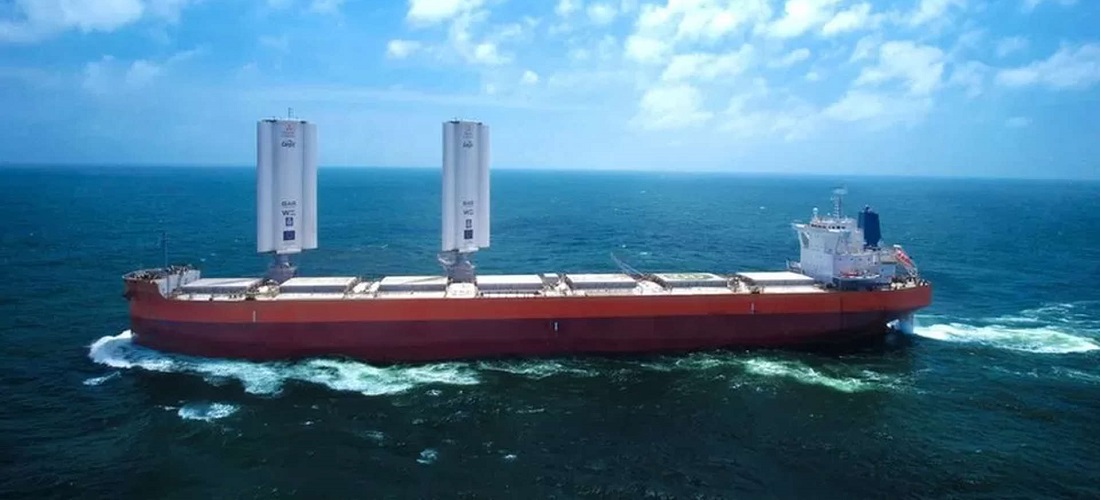
‘Wind-powered’ cargo ship debuts on trip to Brazil
Aug, 22, 2023 Posted by Gabriel MalheirosWeek 202335
A groundbreaking cargo ship, equipped with expansive wind-powered sails, has embarked on its inaugural voyage, marking a significant step toward a greener future for the shipping industry.
Cargill, the shipping company behind this innovation, aims to harness this technology to drive the industry toward more sustainable practices. The utilization of these large British-designed WindWings sails, often referred to as “wings,” seeks to curtail fuel consumption and consequently reduce the carbon footprint associated with maritime transport.
Given that the shipping sector is responsible for roughly 2.1% of global carbon dioxide (CO2) emissions, this advancement is poised to have substantial environmental benefits.
This initiative’s first voyage involves the Pyxis Ocean ship, traveling from China to Brazil. This journey serves as a real-world test of the wind propulsion technology.
The WindWings sails, measuring an impressive 37.5 meters in height and constructed from durable wind turbine materials, are stowed while the ship is in port and unfurled once it sets sail. By allowing the wind to propel the vessel rather than solely relying on the engine, these sails can reduce a cargo ship’s emissions by up to 30%.
Jan Dieleman, President of Cargill Ocean Transportation, acknowledges that the industry is on a transformative “journey to decarbonize.” While he acknowledges that there is no single solution, he points to this technology as evidence of the rapid evolution underway.
Dieleman recalls that only five to six years ago, decarbonization seemed a challenging prospect to many. However, perceptions have drastically shifted, with individuals and industries recognizing the imperative to contribute. He emphasizes the shared challenge of deciphering how to effect meaningful change and underscores Cargill’s commitment to taking risks and pushing the industry forward.
The Pyxis Ocean’s voyage to Brazil, its final destination, is anticipated to span about six weeks. The pioneering technology hails from BAR Technologies, an offshoot of British sailor Ben Ainslie’s team from the 2017 Copa America, often dubbed the “Formula 1 of the seas.”
John Cooper, head of the team at BAR Technologies, expresses his conviction that this voyage will be a pivotal moment for maritime transport. He predicts that by 2025, half of all new ship orders will include wind propulsion. The economic benefits are compelling, with a potential daily fuel savings of one and a half tonnes per day per vessel, equating to six tonnes across four “wings” and a staggering 20 tonnes of CO2 saved daily.
While the innovation itself emerged from the UK, the actual manufacture of the “wings” (WindWings) occurs in China due to lack of government support to reduce imported steel costs.
‘Head Dive’
Wind power for ships is emerging as a promising avenue in the maritime industry’s quest to curtail the staggering 837 million tonnes of CO2 it generates annually.
In July, the sector made a commitment to achieve zero emissions of planet-warming gases “by 2050″—a vow criticized by some as insufficient.
“Wind energy holds significant potential,” affirms Simon Bullock, a navigation researcher at the Tyndall Center at the University of Manchester.
He emphasizes that while cleaner fuels will evolve over time, the immediate imperative is to adopt operational enhancements for existing vessels, such as retrofitting ships with sails, pipes, and rotors.
“While zero-carbon fuels will eventually be requisite for all ships, we are currently compelled to optimize every journey’s efficiency. This also involves slower speeds, a crucial facet of the solution,” he explains to the BBC.
Stephen Gordon, managing director of marine data firm Clarksons Research, concurs that wind-related technologies are making strides.
“The adoption of this technology has doubled within the past 12 months,” he notes.
“However, the current reference point is modest. Among the international shipping fleet and order book, which encompasses over 110,000 vessels, we only have records of fewer than 100 vessels equipped with wind-assisted technology.”
Even if this number rises significantly, wind technology might not be universally applicable, especially in cases where sails interfere with container unloading.
Gordon conducts a comprehensive analysis, pointing out, “The shipping industry lacks a definitive pathway to decarbonization. Given the vastness, complexity, and diversity of the global shipping fleet, a singular solution for the industry in the short or medium term is unlikely.”
However, John Cooper from BAR Technologies holds an optimistic perspective, asserting that the future of wind wings is “extremely promising.”
He acknowledges a sense of satisfaction in reverting to fundamental principles within the industry.
“Engineers may view it unfavorably, but I often liken it to going back to the future,” Cooper muses. “The advent of large combustion engines disrupted trade and maritime routes; now, we’re endeavoring to reverse that trend.”
Source: MSN
To read the original text, click on: https://www.msn.com/pt-br/noticias/ciencia/navio-cargueiro-movido-a-vento-estreia-em-viagem-ao-brasil/ar-AA1fzpqi?rc=1&ocid=socialshare&cvid=aeba3b1d20174ec58269641a662de694&ei=13
-
Ports and Terminals
Nov, 16, 2020
0
ANTAQ director emphasises need to adapt container ports to receive larger vessels
-
Other Logistics
Jul, 31, 2023
0
Rumo and CHS sign a joint venture to build and operate a railroad terminal in Tocantins
-
Sugar and Ethanol
Jan, 03, 2023
0
Brazilian sugar and molasses exports total 2.22mt in December; daily average up 19% YoY
-
Ports and Terminals
Jun, 19, 2023
0
Port of Santos to offer up to 65% discounts based on number of calls


